Should you see a doctor for that skin rash? Experts share advice and home treatments
A skin rash can be so mild that you barely notice it, or it can be severe enough that it's life-threatening. But it's not always easy to tell what type of rash you're dealing with — or how serious the rash is .
In fact, there are more than 3,000 skin diseases out there, Dr. Nada Elbuluk, an associate professor of clinical dermatology at the USC Keck School of Medicine, tells TODAY.com. And people living in different areas of the world or from different ethnic groups may be more likely to experience some skin issues than others.
Some of the rashes that dermatologists see most frequently include eczema, contact dermatitis, hives, rosacea and psoriasis, Dr. Shari Lipner, associate professor of clinical dermatology at the Weill Cornell Medical Center, tells TODAY.com.
Dr. Shasa Hu, who practices in humid Miami, Florida, also commonly sees seborrheic dermatitis, which manifests as flaky dandruff and scaly red patches on the scalp.
Her office also gets seasonal waves of pityriasis rosea, a rash that can be triggered by viral infections, says Hu, an associate professor in the department of dermatology and cutaneous surgery at the University of Miami Miller School of Medicine.
It's important to get your rash diagnosed because some of them can look similar but require different treatments, Lipner says. For instance, "rosacea looks a lot like acne because you can get bumps on the face, but it's actually different and it's treated differently," she explains.
What to look for when deciphering a rash:
Doctors and dermatologists use a few specific clues to help diagnose a rash.
Those factors include:
When the rash started and anything that changed at the same time. For example, did you start using a new skin-care product or taking a new medication around that time?
Symptoms that occur with the rash. For instance, is the rash itchy, burning or raised? Do you have any systemic symptoms along with the rash, such as a fever?
Whether the patient has a history of certain skin conditions, such as eczema or psoriasis, that may be affecting their skin.
Where the rash erupts on the body. Is it just in one location, like your face or one arm, or has it spread to multiple parts of the body?
What were you doing before the rash developed? Sometimes people can develop rashes after spending time outdoors or traveling, or they may be exposed to allergens through their job, for example.
If it's not clear what rash someone is dealing with based on this information, a dermatologist may order a biopsy to help diagnose the condition or to help rule out other possibilities, Elbuluk says.
Rashes can look different depending on your skin tone
"Typically when skin is inflamed, it can sometimes be warm and red. But it's really more red in lighter skin," explains Elbuluk, who is also the founder and director of the USC Skin of Color and Pigmentary Disorders Program.
"In a darker skinned person, you can't appreciate that redness as well because ... if someone has more melanin, that melanin is masking a lot of the redness," she says. In people with darker skin tones, that inflammation may look more purplish, dark brown or reddish brown, Elbuluk says.
For that reason, "the markers that we use for inflammation to diagnose conditions and to assess disease severity are different in darker skin," she adds. So, keep in mind that the same skin condition — everything from psoriasis and eczema to a simple bug bite — may manifest slightly differently depending on skin tone.
How to manage skin rashes at home
In many cases, patients can handle skin rashes at home, especially if it's something they've had before.
Depending on the rash, you may be able to use an over-the-counter treatments first. If your skin looks dry, use a gentle moisturizer, Hu says, and if the rash itches, use an over-the-counter cortisone cream for a week. After that, "If it's not getting better or if it's getting larger, you should see a dermatologist," Hu says.
Additionally, if this type of rash is new to you or you're not sure what it is, it's worth getting an expert's guidance.
To the public, many rashes "can look similar to each other, (but) sometimes they can be very different diagnoses and have different causes," Elbuluk says. For example, some rashes have genetic components while others may be related to environmental exposures, she says. "Part of our job is to help tease apart those different things."
When to seek immediate medical care for a rash
There are a few cases in which you should seek guidance from a medical professional quickly.
Cellulitis. This bacterial infection of the skin can be dangerous if left untreated, Elbuluk says. "The bacteria could spread and even get into your bloodstream, which can be life-threatening," she explains.
Tick bites. Because ticks can spread diseases, such as Lyme disease, it's important to get seen quickly for certain tick bites, Elbuluk says. If needed, your doctor can prescribe prophylactic treatment to help prevent disease.
Drug rashes. Some drug rashes appear as minor patches of pink skin, Hu says. But a few rare drug rashes — toxic epidermal necrolysis and Stevens-Johnson syndrome — come on suddenly, often with a fever and joint pain, she says. These are considered emergencies and need medical attention quickly.
If have a suppressed immune system or certain underlying conditions, like diabetes, and develop a rash, you "should really just see a dermatologist right away because (you) are at higher risk for certain fungal infections," Hu says.
If your rash is severely painful or spreading quickly, no matter what, you should get checked out.
To help you decipher what may be going on with your skin, here are some skin rash pictures, including common rashes as well as rarer conditions to be aware of.
Skin rash pictures
Eczema (atopic dermatitis)
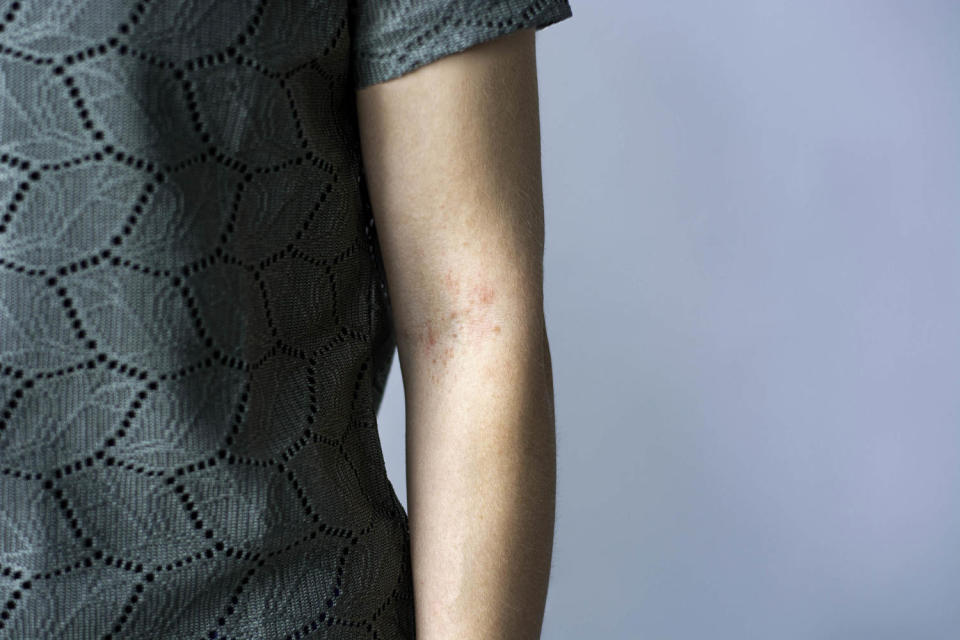
What it looks like:
Eczema is an umbrella term that refers to several conditions that all cause inflamed skin, the American Academy of Dermatology explains. Atopic dermatitis is the most common form of eczema, and sometimes people use the terms interchangeably.
"Mild eczema may be just a small patch of itchy, drier, reddish or pink skin that has a little texture to it," Hu explains. At the more extreme end, eczema can be very itchy, blistered, thick and scaly, the AAD says.
While many people who have eczema have had the condition since childhood, it is possible to develop eczema later in life, Hu says.
Other symptoms:
Along with the rash, atopic dermatitis can feel itchy and dry and may cause skin to feel warm and swollen. After the rash has healed, it may leave skin looking discolored, the AAD says.
Seborrheic dermatitis
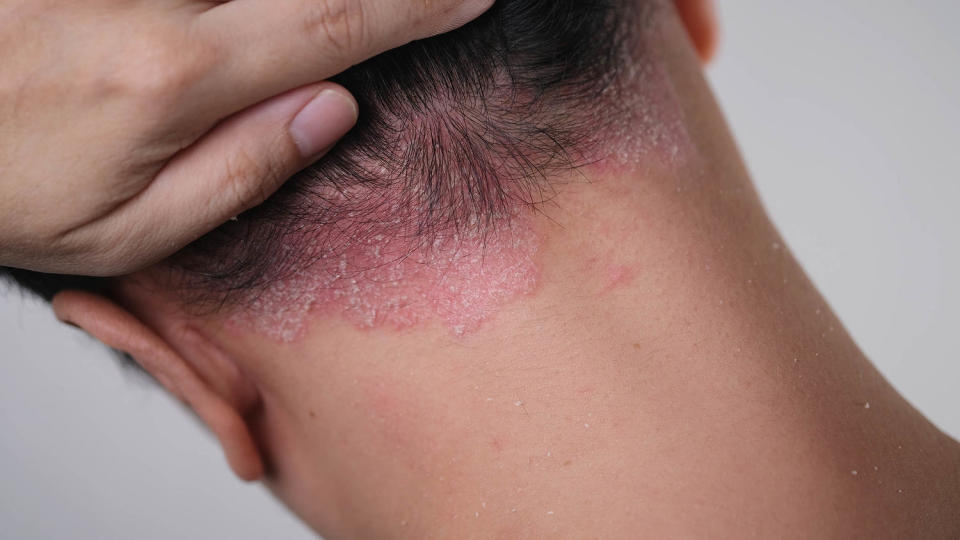
What it looks like:
What we commonly refer to as dandruff is actually a condition called seborrheic dermatitis of the scalp, Hu says. "We see this almost every day," she adds.
The condition causes inflamed patches of skin that can look like a rash, Elbuluk says. Those areas of skin may feel dry, scaly or itchy, and can flake off.
Other symptoms:
Generally, people think about having seborrheic dermatitis on their scalp. "But people don't know that this condition commonly also moves down to affect the eyebrows," Hu explains. You may also notice some patches of seborrheic dermatitis around the nose or near chest hair, she adds.
Psoriasis
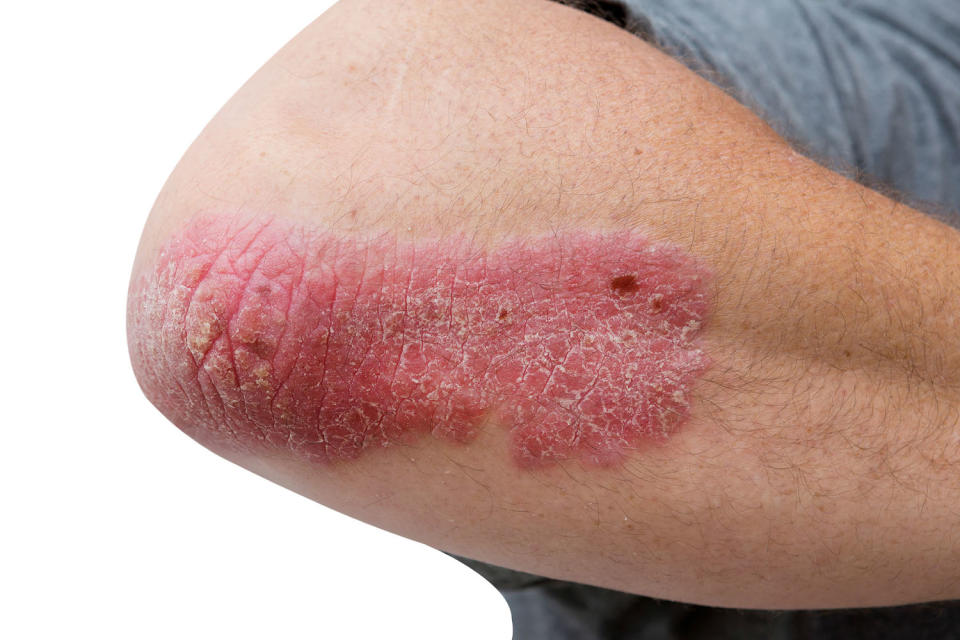
What it looks like:
Psoriasis is another inflammatory condition that dermatologists see frequently, which causes scaly, itchy areas of thickened skin called plaques. They most often appear on the elbows, knees and scalp, but can also affect the nails.
"Typically, patients will get these red plaques with silvery scales," Lipner says. "In patients with darker skin, the plaques tend to be more purplish or brown, and the scales can be more gray rather than silver."
The rashes tend to go through cyclical periods of flare-ups, which can last for weeks or months, the Mayo Clinic says.
Other symptoms:
Psoriasis can sometimes affect the joints, causing a condition called psoriatic arthritis that leads to swelling, stiffness and pain, the AAD explains.
That's another reason it's important to get your skin checked out if you think you may have psoriasis. "Sometimes your skin is a reflection of what's going on inside your body," Elbuluk says.
Acne
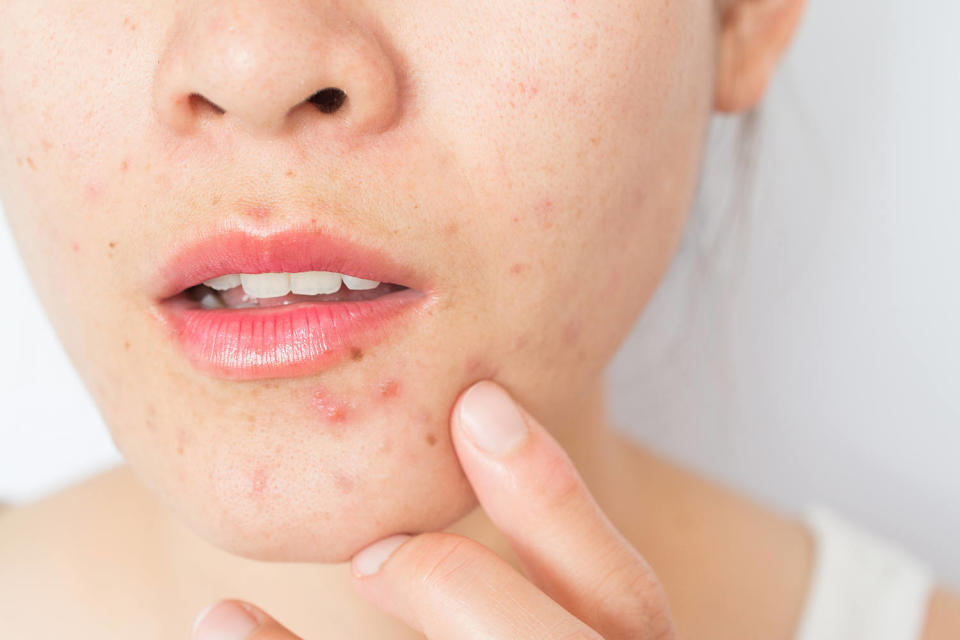
What it looks like:
Acne is another rash that dermatologists see frequently. “It is common in adolescents and teenagers, but it’s not just a skin condition for young people,” Lipner says. “We see plenty of adults with acne, and they’re often surprised that they have it.”
Acne manifests as small red, raised bumps on the face, which may or may not have a white head. The pimples develop when your hair follicles get clogged with dirt, dead skin and bacteria. Acne can be triggered or exacerbated by hormonal fluctuations, stress and some foods.
Other symptoms:
Some types of acne, like cystic and nodular acne, are deeper, painful bumps that don't have a head. You can also develop acne on other parts of the body, such as the chest and shoulders, the Mayo Clinic says.
Rosacea
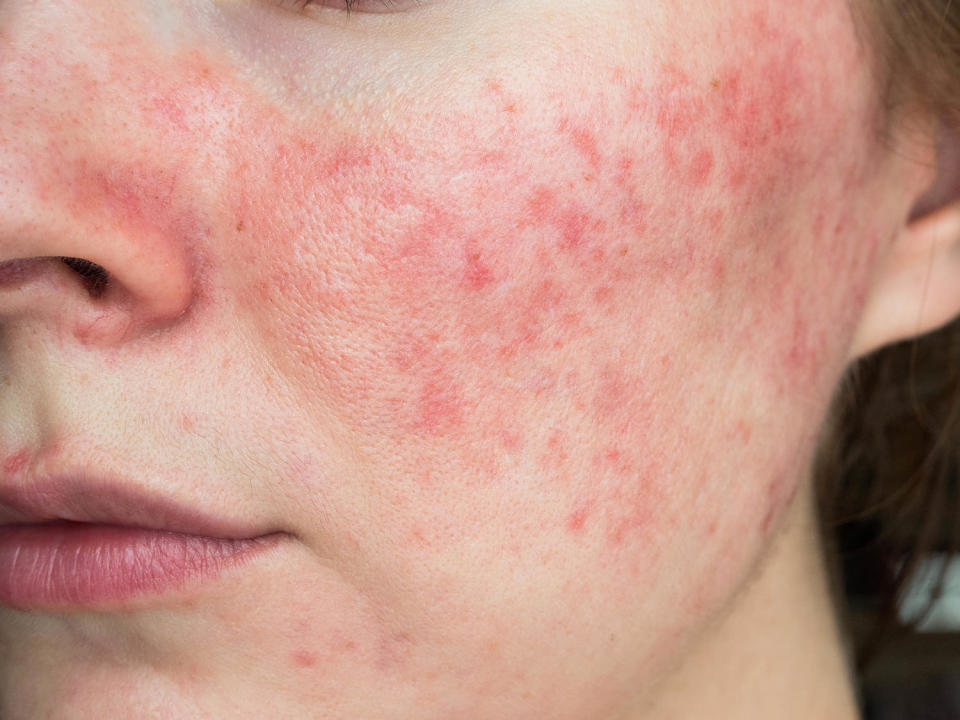
What it looks like:
Rosacea is a common inflammatory skin condition that causes patches of redness on the face or a general "flushed" look, Lipner explains. Different types of rosacea may cause other symptoms, such as acne-like bumps, broken blood vessels or swelling and reddening of the nose.
The symptoms are usually triggered by certain activities, like exercise, or environmental factors, such as cold air.
Other symptoms:
In addition to redness, rosacea may also make skin more sensitive. When the symptoms are triggered, you may also feel a stinging or burning sensation in your skin. Over time, the skin may thicken.
Contact dermatitis
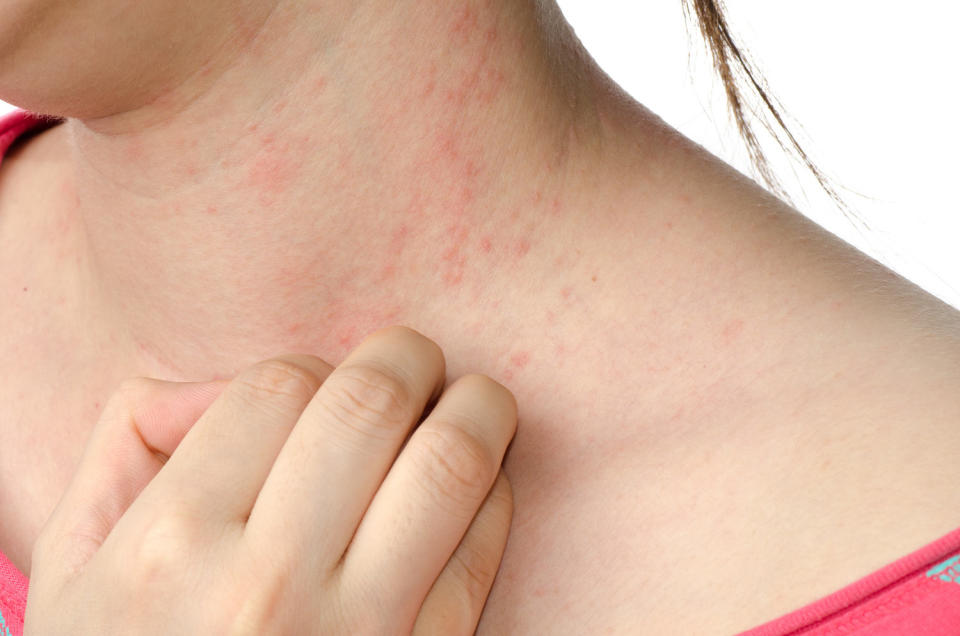
What it looks like:
There are two types of contact dermatitis: irritant and allergic dermatitis.
Irritant contact dermatitis occurs when your skin comes in contact with something that causes some inflammation, Lipner says. For instance, you may notice redness and itchiness if soap or sweat builds under a tight watch band or ring, she says.
On the other hand, allergic contact dermatitis develops when you have an allergic reaction to something that touches your skin. Common examples include poison ivy and nickel allergies, Lipner says. These rashes "tend to be very linear and they can blister," she adds.
In both cases, you'll only see the rash in the area of your skin that came in contact with the irritating substance. With a nickel allergy, for instance, "you'll see it where the button of the jeans would be," Lipner says, "so it'd be a circular area around the belly button."
Other symptoms:
The affected area of skin may be itchy, raised and dry. It might also sting or burn, and you may develop hives or blisters in the area.
Pityriasis rosea
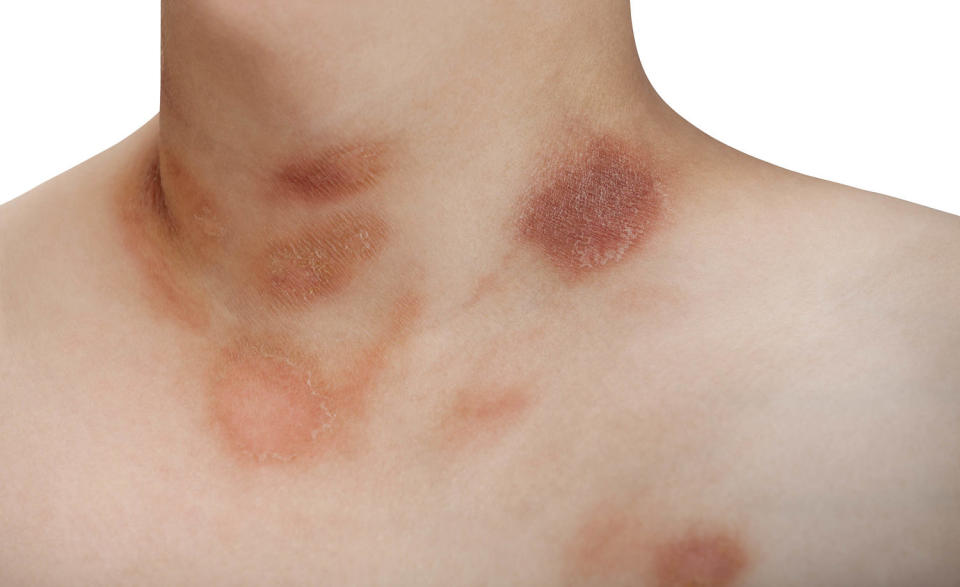
What it looks like:
Once you see a case of pityriasis rosea, you'll never forget it, Hu says. The rash starts with a central circular or oval-shaped area, known as the "herald patch," Hu explains. "Then within a week or two, people notice it spreading throughout the body."
When the rash is in its early stages, patients may think they have a ringworm rash, she adds.
It will often spread to the arms and the trunk, but not the face. The rash also doesn't usually affect the palms of the hands or soles of the feet. That's important because pityriasis rosea can also look like a secondary syphilis rash, Hu says, but syphilis-related rashes can affect the palms and soles, so that's often the first thing dermatologists check when someone presents with a skin issue like this.
It's also important to note that, while pityriasis rosea rash can be alarming, it's not contagious. Syphilis-related rashes, however, are contagious. So it's crucial to get a proper and prompt diagnosis, Hu says.
Other symptoms:
The rash itself is usually asymptomatic, Hu says, meaning it doesn't typically itch or burn. However, some people report feeling mild cold-like symptoms before the rash appears, such as sore throat or fever. Pityriasis rosea may be triggered by certain viral illnesses, but the link isn't certain, Hu adds.
Mosquito bites
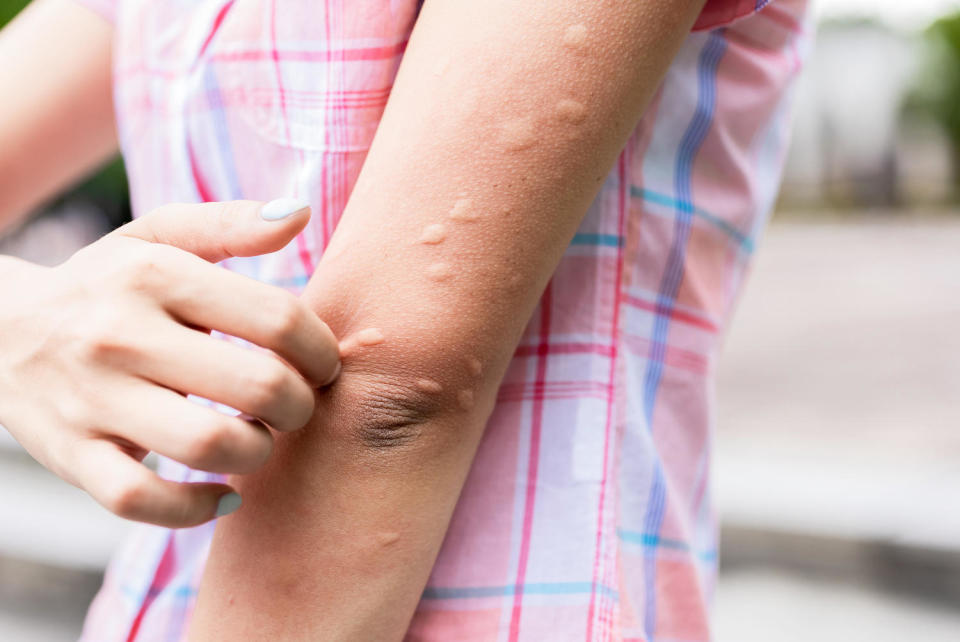
What they look like:
If you're bitten by a mosquito, you'll likely notice raised areas of skin — especially on areas that were uncovered where the bugs may have gotten to you. Additionally, you may even see them biting you or buzzing around, which can give you a clue as to what may have caused your insect bite.
Mosquito bites are typically itchy inflamed bumps that appear within minutes of the bite, the Mayo Clinic explains. They can also manifest as a hive-like spot that forms within 24 hours of the bite, or small blisters.
Other symptoms:
For most people, the itchy, raised bite will be the only symptom of a mosquito bite. But, for those who are allergic to mosquito saliva, more severe reactions sometimes called "skeeter syndrome" can occur, the Mayo Clinic says.
In those cases, people may experience large areas of swelling, changes in skin color and texture, warmth in the area, itchiness, pain and fever, according to the Cleveland Clinic.
Tick bites

What they look like:
Tick bites often aren't easy to spot, experts told TODAY.com previously. “When (ticks are) biting people, ticks have factors in their saliva that prevent pain, clotting and an immune reaction,” said Matt Frye, Ph.D., an entomologist and educator with the New York State Integrated Pest Management Program at Cornell University. "So you may never see any evidence of the tick bite.”
If you do develop a skin response to a tick bite, it may present as a small, itchy bump that's similar to a mosquito bite, the Mayo Clinic says.
It's important to monitor yourself for tick bites if you spend time in areas where ticks live because these tiny creatures can spread certain diseases. Notably, tick-borne Lyme disease may present with a bullseye rash, which develops within 30 days of the bite, the Mayo Clinic explains.
Other symptoms:
Tick bites on their own aren't necessarily going to cause further symptoms. But tick-borne diseases contracted through a bite can cause flu-like symptoms, such as headache, fever, joint and muscle pain or stiffness and extreme fatigue.
Bed bug bites
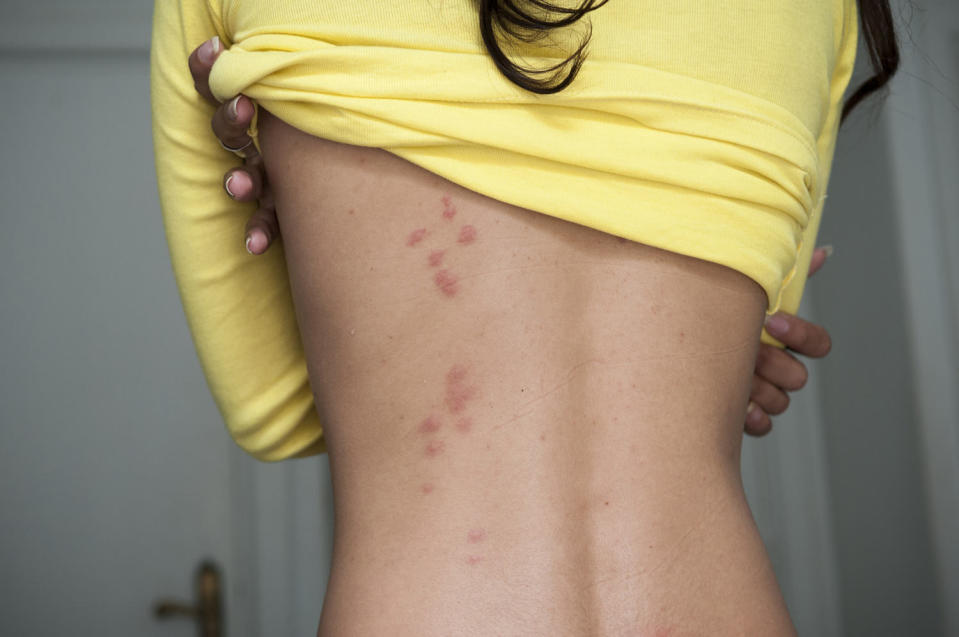
What they look like:
Bed bug bites may look like many other bug bites and skin rashes, experts told TODAY.com previously. Typically, they appear as red, inflamed, raised bumps on the skin that can be itchy.
The bites may appear in a linear fashion, called a "breakfast, lunch and dinner" pattern. And bed bugs often bite in areas that are close to the surface that they're walking on, such as the arm that's closest to your mattress.
Other symptoms:
Along with the bumps, bed bug bites can lead to insomnia and mental health symptoms, such as anxiety, experts said.
Rarely, people may have more severe allergic reactions to bed bug bites, which can lead to itchiness in areas they weren’t bitten, trouble breathing and swelling of the lips and tongue. Symptoms like these indicate a potentially life-threatening reaction called anaphylaxis that requires immediate medical attention.
Hives
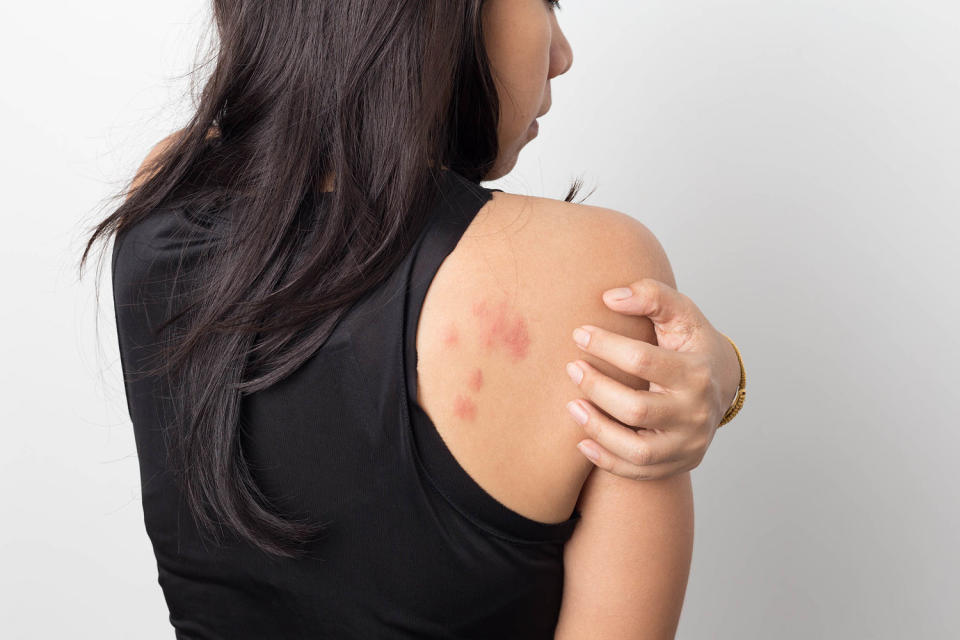
What they look like:
A hives rash, also called urticaria, typically appears as raised, inflamed, itchy welts on the skin. They can each be separate, appear in clusters or merge into a larger swollen bump.
"These look like very juicy red plaques, and they tend to be very itchy," Lipner says. "The hallmark of these is that they come and go within 24 hours. So one will appear, and it will disappear."
If you're not sure if you have hives, you can draw a mark around one of the bumps and see if it goes away within a day, Lipner says. However, new bumps can continue to develop.
Other symptoms:
Hives can present as an allergic reaction to something, like pollen or certain foods, so you may have other allergy-related symptoms along with the hives.
Keratosis pilaris
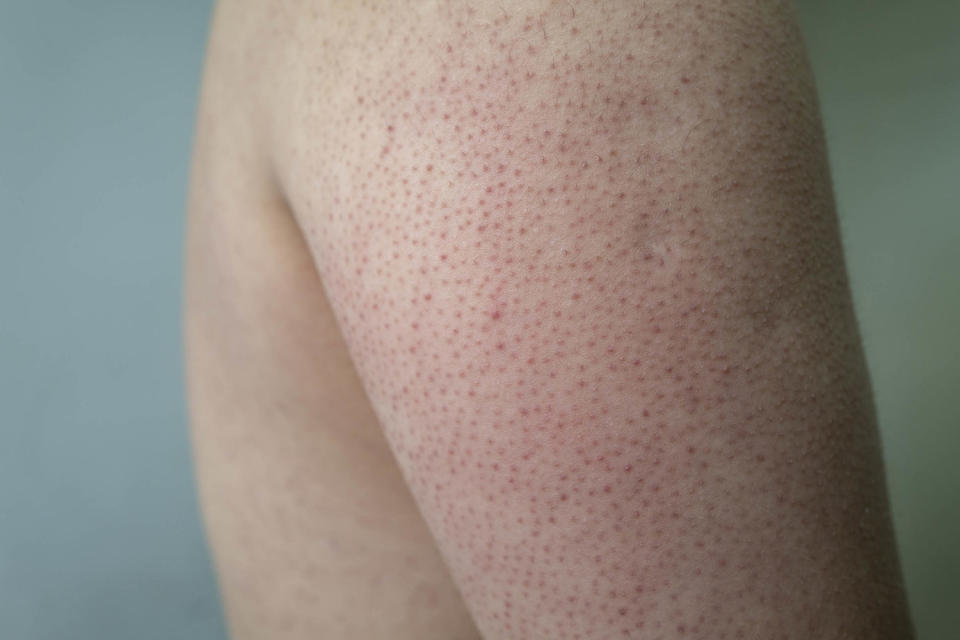
What it looks like:
Keratosis pilaris causes small harmless bumps that are sometimes referred to as "chicken skin." The bumps may be raised and flesh-colored or red and pimple-like, the AAD explains. And the condition most often appears on the upper arms and the backs of the thighs.
Other symptoms:
The bumps may cause the skin to feel dry or rough, and skin affected by keratosis pilaris might also be itchy.
Caused by a buildup of dead skin cells, keratosis pilaris isn't harmful and doesn't need to be treated. But if you find the dryness or the bumps bothersome, you can use over-the-counter products to address them.
Perioral dermatitis
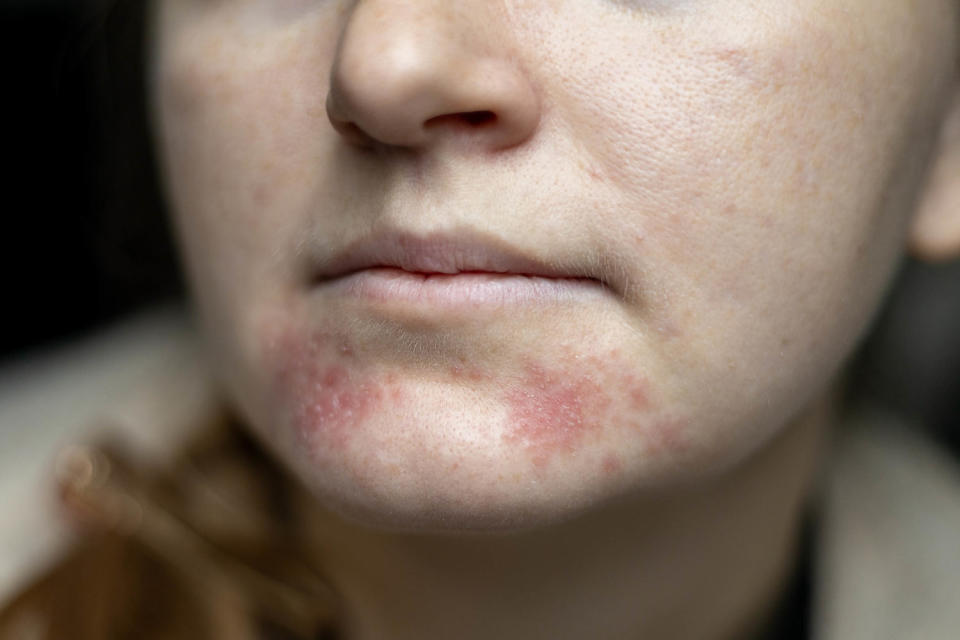
What it looks like:
Perioral dermatitis is a rash that appears as clusters of inflamed skin and small raised bumps around the mouth and nose. The bumps may be red or flesh-colored, depending on your skin tone, the AAD says. The rash may also look like small acne pimples.
Experts aren't totally sure what causes perioral dermatitis, but some believe it's related to rosacea. The rash may be triggered by certain products, like toothpaste or skin care products. Using topical steroid medications may also trigger flare-ups of perioral dermatitis.
Other symptoms:
In addition to the bumpy rash, perioral dermatitis may cause a burning or stinging sensation in the affected skin, the AAD says. It may also be itchy.
Shingles
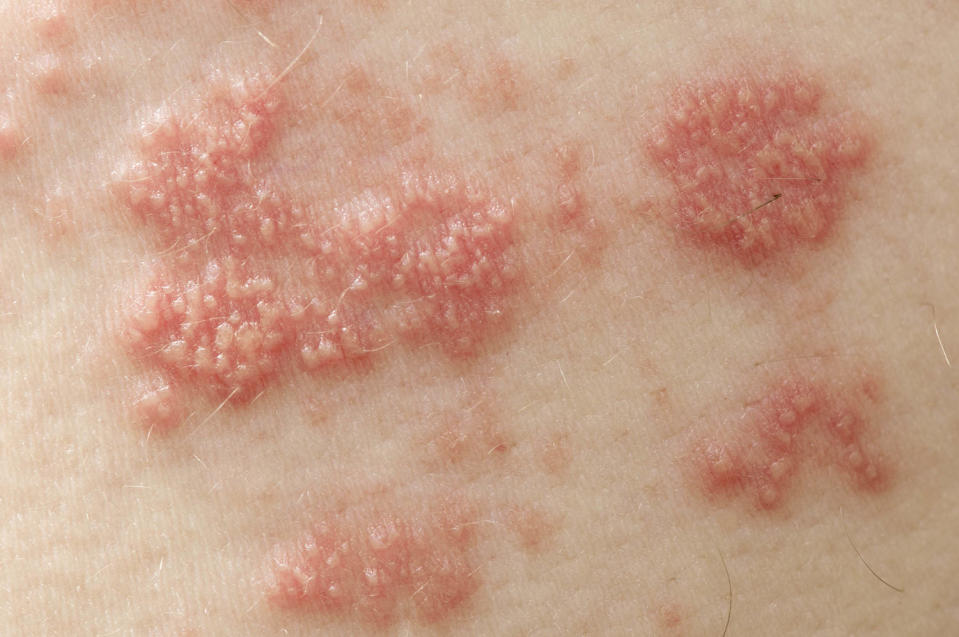
What it looks like:
Shingles is a condition caused by the same virus that causes chickenpox, the AAD explains. After you get over chickenpox, the virus stays dormant in your nerves and can reappear as a painful rash.
A shingles rash typically appears in specific areas of the body (dermatomes) that are connected to certain nerves, Lipner explains. Usually, people only experience a shingles rash in one part of the body and on only one side, most often the torso.
The rash may start as patches of redness or discolored skin before developing into small, painful blisters. Over the next few weeks, the blisters may burst open and scab over, the AAD says.
Other symptoms:
A day or two before the rash appears on your skin, you may feel a burning, tingling or electrical zapping sensation in the area, the AAD says. Once the rash appears, some people also develop flu-like symptoms, including fever, muscle aches or vomiting.
It's important to get prompt treatment for a shingles rash because, although the rash itself will go away on its own, there can be after-effects. "The earlier you treat, the less of a chance there will be that the patient will have long-lasting pain," Lipner says.
Elbuluk agrees: "You can have pain where you had shingles for months and months."
Experts also recommend that older adults get the shingles vaccine to help prevent the illness. Younger people who have weakened immune systems may also receive the vaccine.
Folliculitis
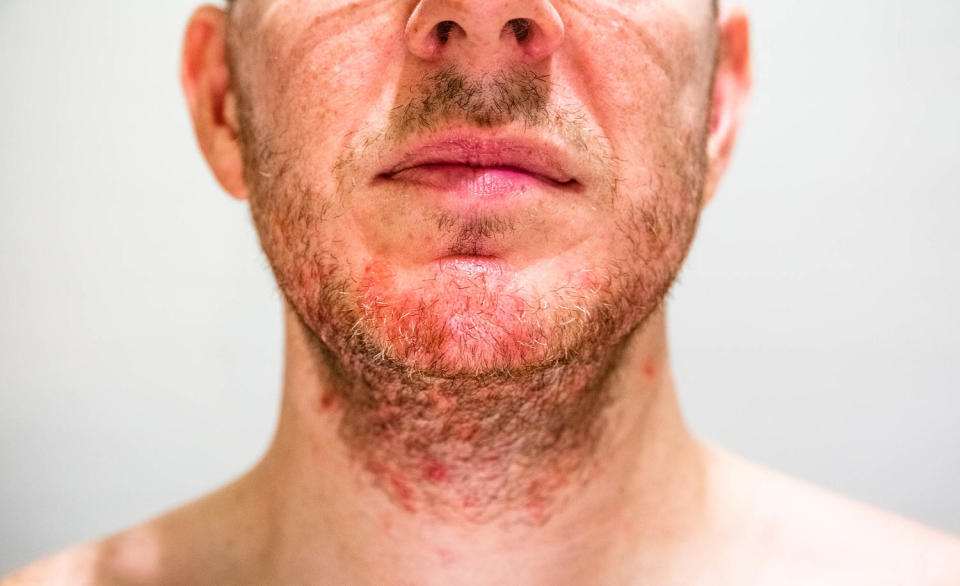
What it looks like:
Folliculitis may look a lot like acne pimples, but it has a very different cause: infected hair follicles.
The condition typically causes areas of skin with small inflamed bumps around hair on the body, the AAD says. This can happen if you shave your hair or if the hair follicle gets damaged from tight clothing. For example, people who shave their facial hair may develop folliculitis around the chin, or it can show up after biking in tight, sweaty clothes, the AAD explains.
Each bump can also develop a red or discolored ring around it, which signals that there's an infection.
Other symptoms:
Folliculitis bumps may be painful and may also be itchy, the AAD says. Thankfully, the infection can usually be managed with home treatments, like warm compresses, and goes away on its own within a few weeks.
Hand, foot and mouth disease

What it looks like:
Hand-foot-and-mouth disease is a distinctive rash caused by the Coxsackie virus, as TODAY.com explained previously.
As the name implies, "people will get blisters on their hands and feet, and also in their mouth," Lipner explains. The rash starts as red bumps on the soles of the feet or palms of the hands, which then turn into blisters, the AAD says.
While this condition is most commonly found in kids, children can spread it to adults, Lipner adds, and adults can develop severe cases.
Other symptoms:
The rash is often itchy, the AAD says. And, along with the rash, there may be other viral symptoms, such as swollen lymph nodes, sore throat, mild fever, stomach pain and lack of appetite.
Ringworm
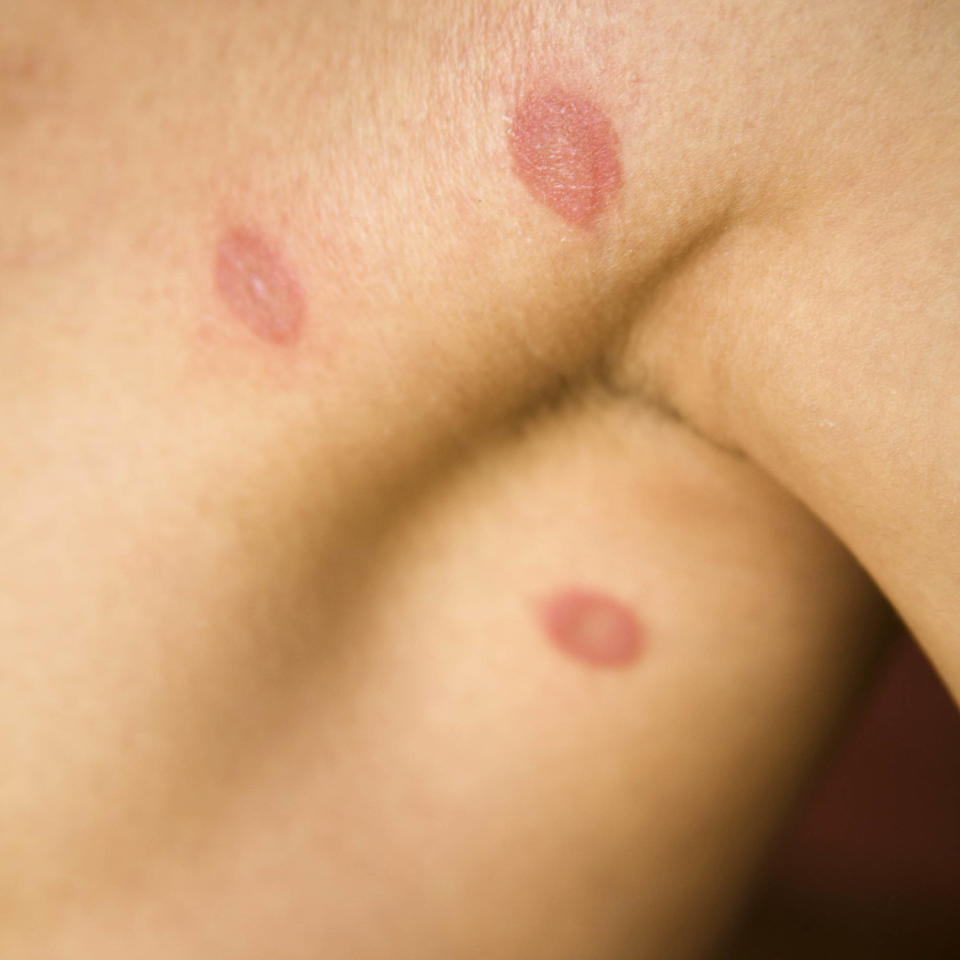
What it looks like:
Despite the name, ringworm rashes are not caused by worms. Instead, ringworm is a sign of a fungal infection on the skin. (Athlete's foot is a common form of ringworm.)
Ringworm rashes are round, red and itchy patches of skin, TODAY.com explained previously. In people with darker skin tones, the skin may look brown or gray, the AAD says. The skin may also look scaly and cracked. However, ringworm may look a little different depending on where it shows up on the body, the AAD explains.
Other symptoms:
Ringworm rashes are often quite itchy and may also come with a burning or stinging sensation. If the rash appears on the feet, you may also notice a foul odor, the AAD says. Or, if it appears on the hands, it may look cracked as if the skin is extremely dry.
Heat rash
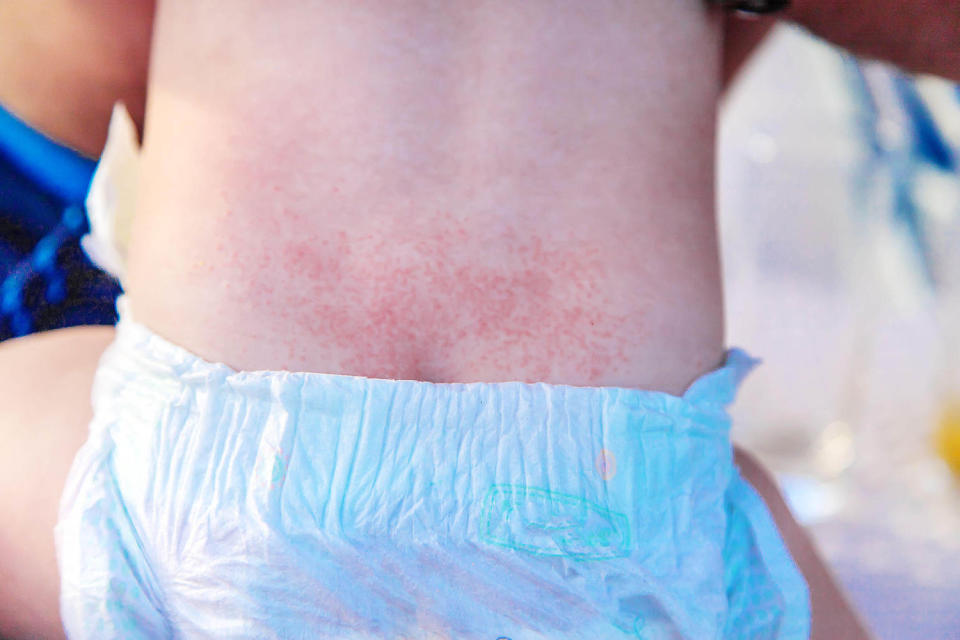
What it looks like:
Heat rashes look like small flesh-colored or red bumps in the skin, which develop when sweat gets trapped. In its mildest form, a heat rash may also look like tiny, clear fluid-filled blisters, the Mayo Clinic says.
This can happen when you're sweating excessively or when the sweat glands get clogged, which causes the sweat to pool up in your skin, TODAY.com explained previously.
Babies may develop heat rash around the groin or along the diaper line. In adults, heat rash typically shows up on parts of the body where tight clothing restricts the skin or where skin folds, the Mayo Clinic says.
Other symptoms:
If a heat rash becomes inflamed, the bumps may be painful, itchy or have a stinging or prickly feeling. They may also become filled with pus, depending on how deep within the skin the sweat is trapped, the Mayo Clinic says.
Impetigo
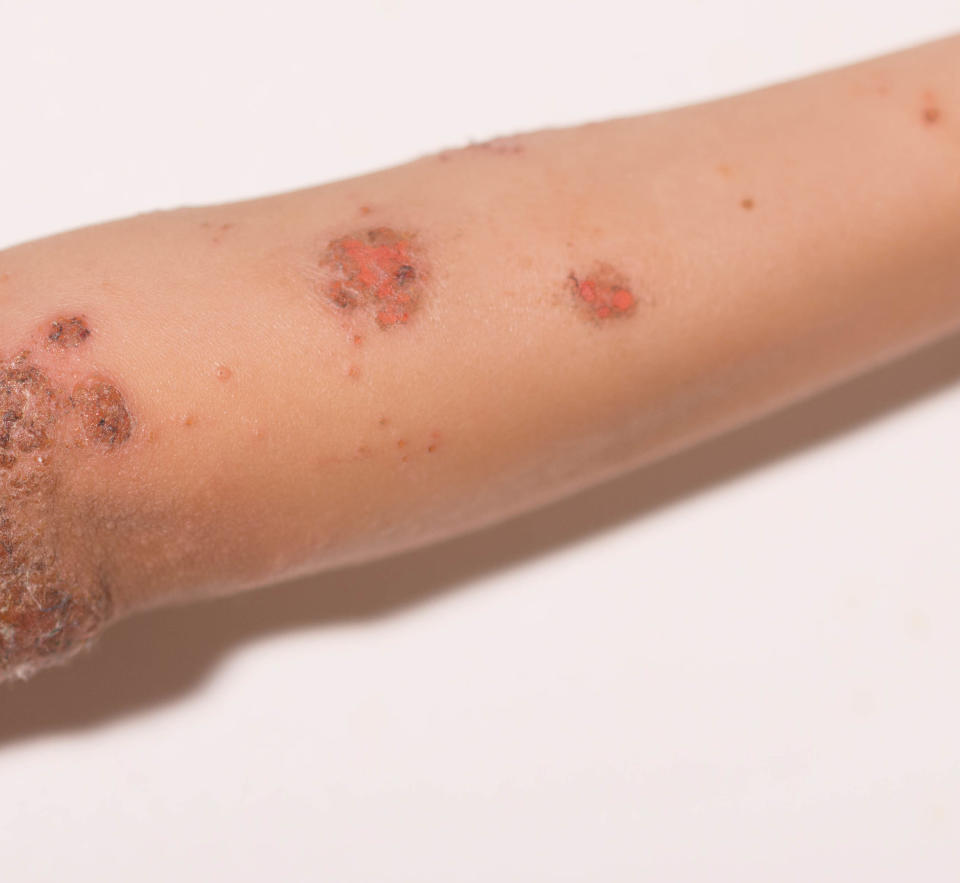
What it looks like:
Impetigo is a skin infection that commonly affects kids, the AAD explains. Caused by staph or strep bacteria that's found its way into the top layers of skin, impetigo is contagious and can spread via skin-to-skin contact, the AAD says, like while playing contact sports, for instance.
The condition causes itchy blisters or sores that burst open, leaving skin red and raw. From there, the areas develop a "honey-colored" crust, the AAD says. The rash and blisters can spread to other areas of the body, which is why it's important to seek treatment early for impetigo.
Other symptoms:
An impetigo rash is typically itchy, and you may notice swollen glands nearby, the AAD says. Dermatologists typically prescribe antibiotic cream to treat impetigo.
Tinea versicolor
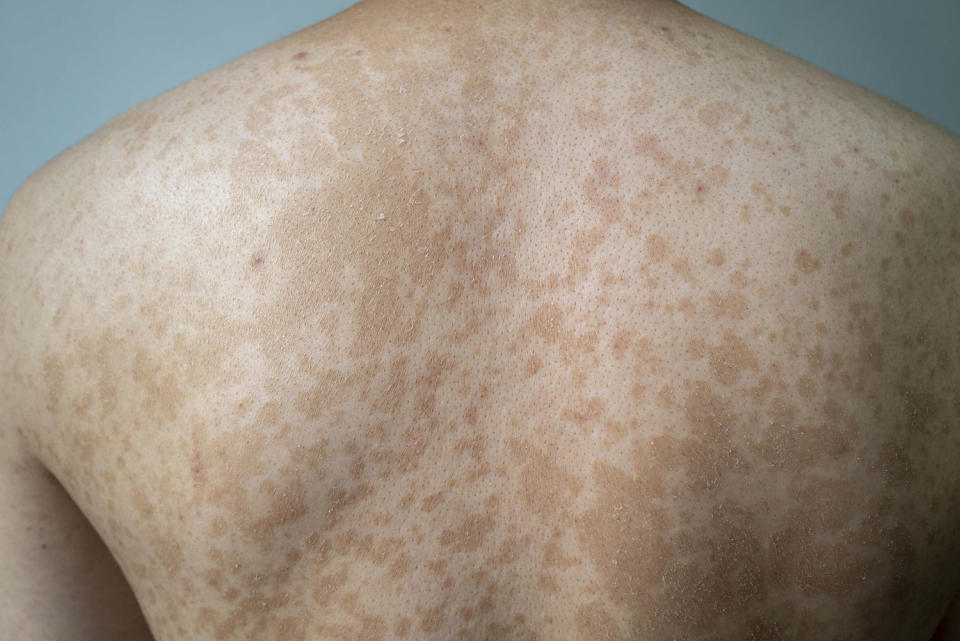
What it looks like:
Tinea versicolor is a rash caused by an overgrowth of normally-occurring yeast on the skin, which leads to patches of discolored skin. The patches may be so faint you don’t notice them, or they may be so pronounced that they’re mistaken for vitiligo, the AAD says.
In people with lighter skin tones, the condition causes "pink scaly areas, usually on the chest and back," Elbuluk says. "But in darker-skinned people, it can actually cause lightening of the skin," she adds.
Dermatologists frequently see tinea versicolor in the summertime because sweat and heat exacerbate the condition, Ebuluk says.
Other symptoms:
Tinea versicolor tends not to cause symptoms beyond the skin changes, Elbuluk explains. “People tend to see it more than anything else,” she says. It may cause the skin to be itchy, scaly or dry, the AAD says, but not always.
Cellulitis
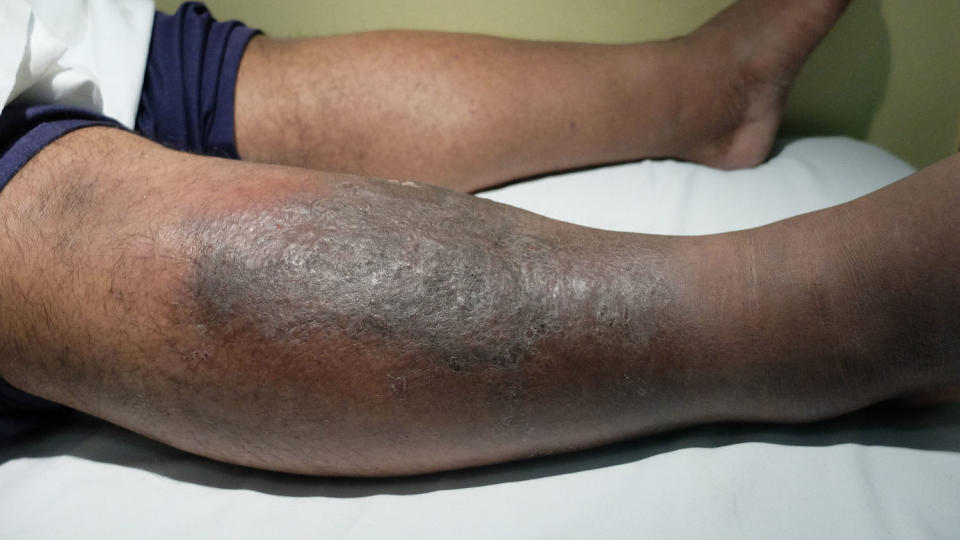
What it looks like:
Cellulitis is a potentially serious bacterial skin infection, Elbuluk says.
The condition often affects the lower legs and causes swelling, redness and warmth in the area, the AAD says. In patients with darker skin tones, the skin may look dark brown rather than red. Additionally, cellulitis typically only affects one limb at a time.
In severe cases, the skin may blister and fill with pus, or the skin might develop red streaks. Nearby lymph nodes may also be affected and feel swollen, the AAD says.
Other symptoms:
Skin affected by cellulitis is typically swollen, warm and hard to the touch, the AAD says. If you have cellulitis, you may also feel sick, including symptoms such as fever, chills and fatigue. In more severe cases, patients may develop intense pain, night sweats, nausea, trouble concentrating and nausea.
If you think you may have cellulitis, you should get prompt medical attention because the infection can enter the bloodstream and cause potentially life-threatening symptoms.
Cutaneous T-cell lymphoma
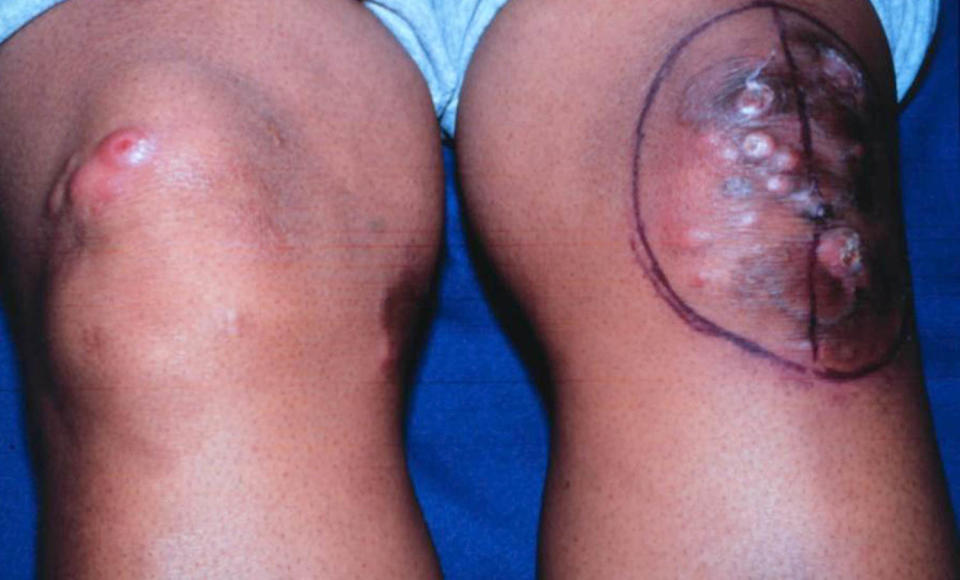
What it looks like:
Cutaneous T-cell lymphomas are a group of cancers that cause skin rashes. The two most common types of CTCL are mycosis fungoides and Sezary syndrome, the AAD says. These rare and serious conditions are sometimes dismissed as eczema, Hu says, and disproportionately affect Black people.
The conditions may start as patches of red or discolored itchy skin that don't go away. In people with lighter skin tones, the patches may look like red rashes or sunburns, the AAD says, while people with darker skin tones may see darker brown or purple rashes. As the cancer progresses, some people may develop itchy psoriasis-like plaques, light spots, nodules or tumors on the affected skin.
That's why, if a patient's eczema is not getting better, Hu often calls for a biopsy just to make sure they're not missing an undiagnosed CTCL.
Other symptoms:
CTCL is often itchy and can be so itchy that it's hard to sleep at night.
But the other symptoms of CTCL can vary depending on exactly which condition you're dealing with and what stage the cancer is in, the AAD explains. You may notice hair loss or skin infections, for instance, or you may feel under the weather with symptoms like fatigue, fever and weight loss.
Drug rashes
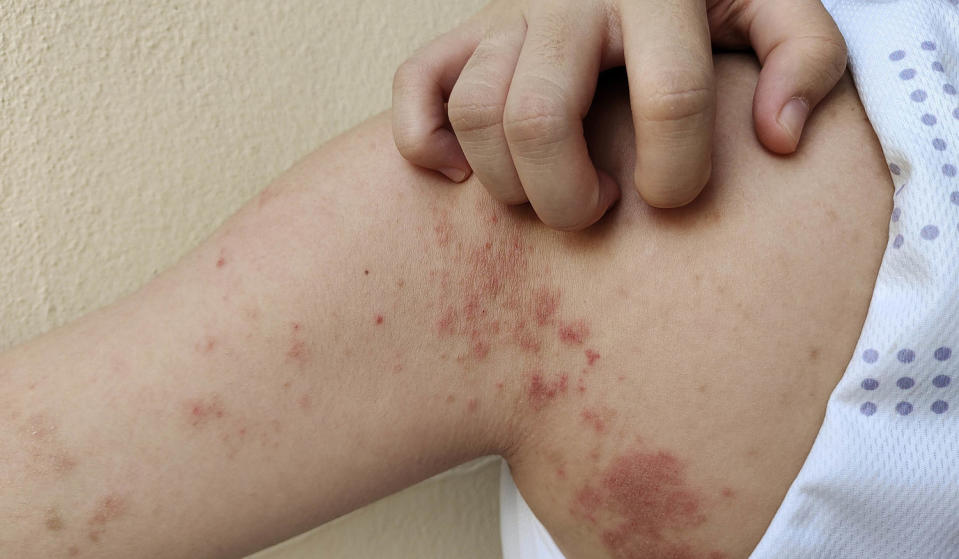
What it looks like:
Drug rashes include a few different types of rashes that appear after taking new drug, and they can run the gamut from mild to severe.
Hives and other allergic reactions may develop after taking medication, for instance. Other medications cause rashes as a known side effect or as a reaction to sunlight, Johns Hopkins Medicine says.
At the more serious end is Stevens-Johnson syndrome, Hu says, which starts with flu-like symptoms and a blistering, painful rash. The rash also typically spreads quickly, the Mayo Clinic says. Stevens-Johnson syndrome is considered a medical emergency and requires prompt treatment, Hu says.
An even more severe and life-threatening form of the condition is called toxic epidermal necrolysis, which causes the skin to peel off in sheets, Johns Hopkins Medicine explains.
Other symptoms:
You should talk to your doctor any time you have a rash within a few weeks of taking a new medication. Many of the symptoms of a drug rash may also be caused by other common skin conditions, so it's important to get checked out quickly if you're unsure.
This article was originally published on TODAY.com

